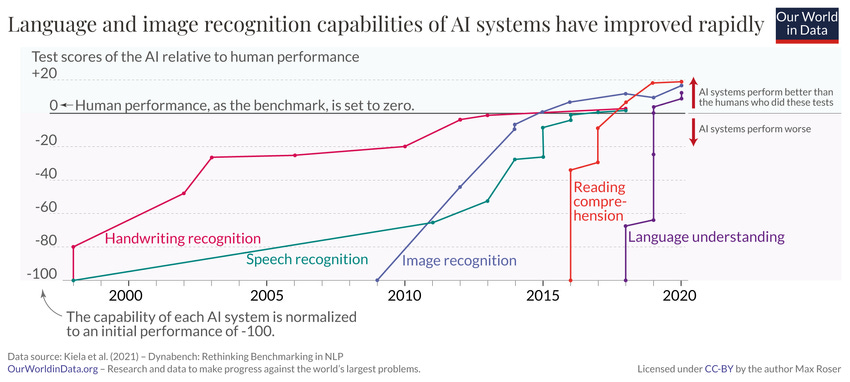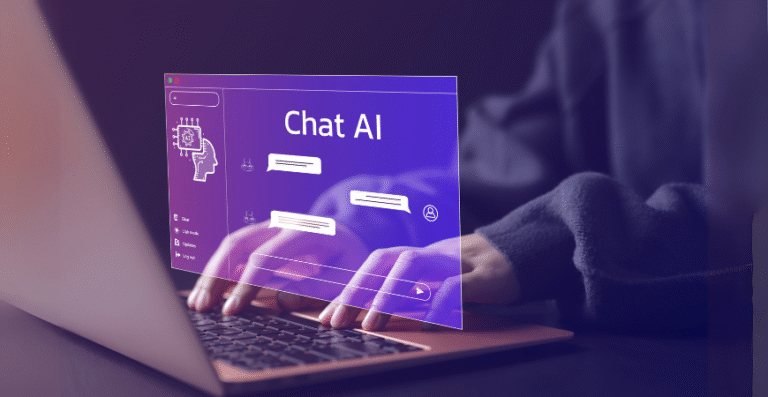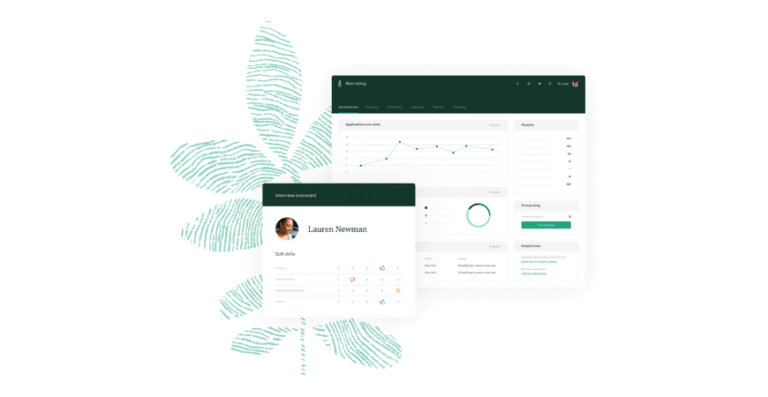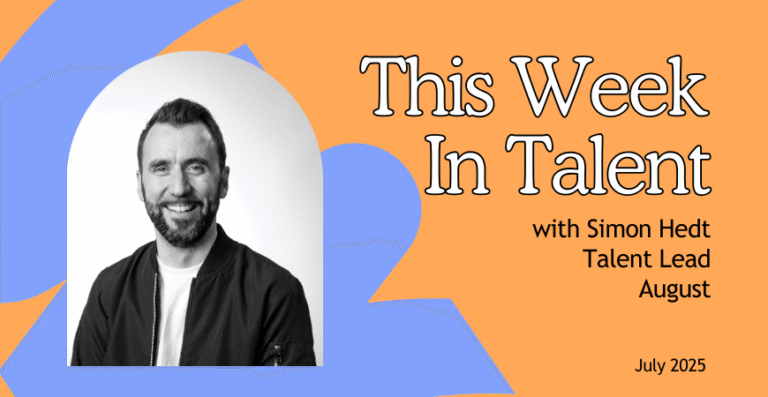Every day, new announcements about AI and its growth surprise and frighten.
A few days ago, ChatGPT4 announced that it could now speak in five languages and answer questions about photos you present to it. For example, you could show it a picture of a machine, and it would identify it and perhaps even diagnose if something is wrong. This capability is available to anyone subscribing to the $20 monthly premium for ChatGPT4.
But beyond this news is AI’s overall progress in understanding written and spoken language. The image below shows that AI can now exceed humans’ reading comprehension and language understanding.
This is possible because of increased computing power and the enormous investments made by firms like Microsoft and Google. The amount of computation used to train AI systems has increased exponentially as the cost of computing has fallen yearly while its capability grows.

A Brief History of AI
The journey to get to this point is long. Many thought we would never achieve what we now have, while others thought we would advance quickly to the Singularity. Singularity, popularized by Ray Kurzweil, is the time when computers will be indistinguishable from people or will have replaced us in intelligence. This NYT article is an excellent introduction to where we are on that journey.
Getting to ChatGPT has been spotty, and only recently, with increased computing power and the breakthrough in neural networks, have we advanced.
This chart overviews the development timeline with a long gap when nothing much changed between the 1990s and 2020.

AI and Recruiting
What does this mean for recruiting? Is it the end of recruiting as we knew it? Probably. The skills that got us to where we are are becoming less and less relevant. Many of those skills can be and have been co-opted by emerging AI-based tools. Leading organizations use these tools to find, screen, assess, and engage candidates without the candidates’ awareness.
According to Pew Research, most Americans (61%) have heard nothing about the AI employers use in hiring. Candidates are largely unaware that they are being screened or assessed by AI.
I was on a plane this evening and sat beside a young recent graduate from university. He told me about his experience being interviewed by AI developed by HireVue. He was not intimidated or angry but curious as to how it worked. He felt it was a positive experience.
The reality is that more and more recruiting functions are incorporating AI into their processes. One question I will not try to answer here is whether or not we should be more transparent about how we use AI and what that means for a candidate.
At a more practical level, there has always been concern that candidates do not like to interact with a computer and prefer to speak with a natural person. While it is true that we are social beings and want to talk to others, it is also true that we appreciate fast, efficient, and candid service.
It is a myth that candidates do not like interacting with computers or chatbots. There is a long history of people engaging positively with them.
I was involved superficially in an attempt to use AI in the late 1980s and early 1990s. We were intrigued by an early chatbot and an often-cited application of AI called Eliza. This was a chatbot developed at MIT that presented itself as a psychotherapist. It responded to users’ quests using non-directional responses that repeated or rephrased what the patient said. The programmer was shocked that many people thought of speaking with an actual human. You can try Eliza here.
Is the growth of AI the end of Recruiting as we now know it? And is it this bad?
Experiments over the past few years have shown that people generally respond positively to interactions with chatbots. Chatbots streamline recruiting, remove mundane and administrative duties, and give more time for recruiters to develop strategy, improve the recruiting brand, and develop strong relationships with hiring managers.
Where We Are Using AI in Recruiting
I have listed a handful of areas where AI is already being used or soon will be in recruiting.
- AI will understand resumes, identify skills and experience, and use that to qualify and rank candidates.
- Write job descriptions that are engaging and candidly reflective of the work.
- Post job descriptions to a targeted audience
- Source and screen candidates through a combination of looking at existing data and analytics to match candidates to jobs and skill needs
- Communicate with candidates intelligently, answering their questions and concerns without having been previously explicitly programmed with the answers.
- Assess skills and capabilities based not only on rote mimicry of what is in the job description but also on its interpretation of what is needed based on analytics of the job need and the success of previous job holders.
- Conduct interviews using natural language in multiple languages.
- Generate all desired or required reports for internal leadership and to meet legal requirements.
- Provide onboarding input and engage candidates before arrival
- Analyse the success of a recruiting campaign
- Develop hiring plans and forecast needs based on historical data and economic performance.
Limits to AI in Recruiting
Not everything is rosy with AI. At the basic level, we are still on a learning curve with the adoption and integration of AI into our recruiting flow. It can be expensive to acquire. To fully utilize AI, a recruiting function will need technical savvy to integrate and meld it into current processes or redesign them entirely.
At a more advanced level, the algorithms in some AI tools may be biased, search algorithms cannot find people who do not have an online presence, and job descriptions and candidate analysis require data that many organizations cannot tap or do not have.
However, the trajectory is forward. AI will increasingly be a part of recruiting, and within a decade, it will have replaced many of the things recruiters now do. Recruiting, as we have known it, will have morphed into a more relationship-driven role. Recruiters can focus on marketing, branding, and building better relationships with hiring managers. There may be fewer recruiters, but those who remain will truly add value and gain influence. Surely, this is good.
NOTE: The charts and data in this article are taken mainly from Our World in Data.
This article was originally published in the Future of Talent Weekly Newsletter and has been re-published here with permission.
Want to know more about the opportunities and limitations of AI in recruiting? Join us at ATC2023 on 22nd & 23rd November at Luna Park Sydney to hear more from Kevin Wheeler and other Talent Leaders and Experts.







